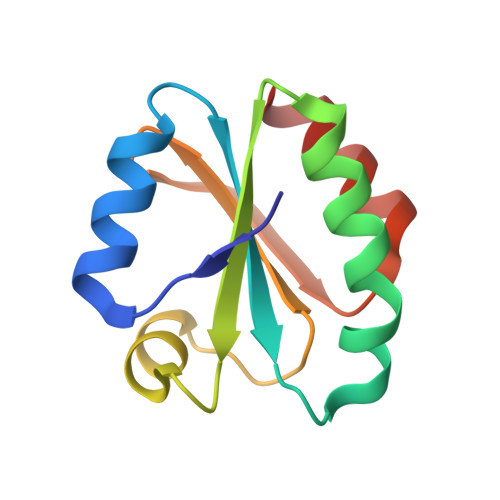Expression, Purification, Crystallization and X-Ray Crystallographic Studies of Different Redox States of the Active Site of Thioredoxin 1 from the Whiteleg Shrimp Litopenaeus Vannamei
Campos-Acevedo, A.A., Garcia-Orozco, K.D., Sotelo-Mundo, R.R., Rudino-Pinera, E.(2013) Acta Crystallogr Sect F Struct Biol Cryst Commun 69: 488
- PubMed: 23695560
- DOI: https://doi.org/10.1107/S1744309113010622
- Primary Citation of Related Structures:
3ZZX, 4AJ6, 4AJ7, 4AJ8 - PubMed Abstract:
Thioredoxin (Trx) is a 12 kDa cellular redox protein that belongs to a family of small redox proteins which undergo reversible oxidation to produce a cystine disulfide bond through the transfer of reducing equivalents from the catalytic site cysteine residues (Cys32 and Cys35) to a disulfide substrate. In this study, crystals of thioredoxin 1 from the Pacific whiteleg shrimp Litopenaeus vannamei (LvTrx) were successfully obtained. One data set was collected from each of four crystals at 100 K and the three-dimensional structures of the catalytic cysteines in different redox states were determined: reduced and oxidized forms at 2.00 Å resolution using data collected at a synchrotron-radiation source and two partially reduced structures at 1.54 and 1.88 Å resolution using data collected using an in-house source. All of the crystals belonged to space group P3212, with unit-cell parameters a = 57.5 (4), b = 57.5 (4), c = 118.1 (8) Å. The asymmetric unit contains two subunits of LvTrx, with a Matthews coefficient (VM) of 2.31 Å(3) Da(-1) and a solvent content of 46%. Initial phases were determined by molecular replacement using the crystallographic model of Trx from Drosophila melanogaster as a template. In the present work, LvTrx was overexpressed in Escherichia coli, purified and crystallized. Structural analysis of the different redox states at the Trx active site highlights its reactivity and corroborates the existence of a dimer in the crystal. In the crystallographic structures the dimer is stabilized by several interactions, including a disulfide bridge between Cys73 of each LvTrx monomer, a hydrogen bond between the side chain of Asp60 of each monomer and several hydrophobic interactions, with a noncrystallographic twofold axis.
Organizational Affiliation:
Departamento de Medicina Molecular y Bioprocesos, Instituto de Biotecnología (IBT), Universidad Nacional Autónoma de México (UNAM), Avenida Universidad 2001, Colonia Chamilpa, 62210 Cuernavaca, Morelos, Mexico.

















